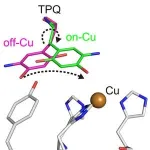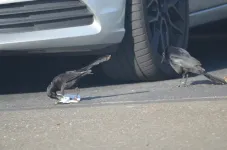(Press-News.org) A research group led by Professor Emeritus Michio Homma (he, him) and Professor Seiji Kojima (he, him) of the Graduate School of Science at Nagoya University, in collaboration with Osaka University and Nagahama Institute of Bio-Science and Technology, have made new insights into how locomotion occurs in bacteria. The group identified the FliG molecule in the flagellar layer, the ‘motor’ of bacteria, and revealed its role in the organism. These findings suggest ways in which future engineers could build nanomachines with full control over their movements. They published the study in iScience.
As nanomachines become smaller, researchers are taking inspiration from microscopic organisms for ways to make them move and operate. In particular, the flagellar motor can rotate clockwise and counterclockwise at a speed of 20,000 rpm. If scaled up, it would be comparable to a Formula One engine with an energy conversion efficiency of almost 100% and the capacity to change its rotation direction instantly at high speeds. Should engineers be able to develop a device like a flagellar motor, it would radically increase the maneuverability and efficiency of nanomachines.
The flagellar motors in bacteria have a rotor and a stationary component that surrounds it, known as the stator. If the flagellum was a part of a car, the stator would be the engine. The rotation of the stator is transmitted to the rotor like a gear, causing the rotor to rotate. Depending on the rotation, the bacterium moves forward or backward, like an automatic car with reverse and drive settings. A protein complex called the C ring controls this motion.
Inside the C ring, the FliG molecule acts like the clutch, switching from forward to backward movement. Like a car, the parts must work together. The slightest change can affect the motor. In the flagellar motor, these tiny changes are mutations. Homma's group studied the G215A mutant in FliG, which causes clockwise permanent rotation of the motor, and compared it with the non-mutated form that can move in both forward and backward directions.
When they tested the G215A mutant of the marine organism Vibrio alginolyticus, they found that this clockwise motion was because of changes in FliG and the interaction of water molecules around the protein. They also saw these changes in the normal form when it rotated clockwise. However, these differed from those seen when it rotated anticlockwise.
“The flagellar motor rotates in both directions: clockwise to move backward and counterclockwise to move forward,” said Homma. “In this study, we found that the structure of FliG and the interaction of water molecules around it are different when the motor moves clockwise and counterclockwise. This difference allows bacteria to instantly switch between forward and backward movements in response to environmental changes.”
“The clarification of the physical properties of the FliG protein in motors is a significant breakthrough in our understanding of the molecular mechanism that switches the direction of rotation of motors, suggesting ways to create compact motors with higher energy conversion efficiency,” said Homma. “Using these findings, it will be possible to design artificial nanomachines that can freely control their rotation, which is expected to be applied to various future fields such as medicine and the design of artificial life.”
END
Understanding bacterial motors may lead to more efficient nanomachine motors
2023-09-20
ELSE PRESS RELEASES FROM THIS DATE:
New tool will help to diagnose form of extreme social isolation
2023-09-20
A new evaluation tool offers practical guidance for diagnosing an extreme form of social isolation known as hikikimori.
The diagnostic evaluation tool was published online Sept. 15 with an accompanying letter by co-authors in the journal World Psychiatry. The tool is the first structured technique to evaluate people who suffer from a condition first recognized in young people in Japan, but believed to be widely shared in people of all ages across the globe.
Known as the Hikikomori Diagnostic Evaluation, or HiDE, the tool provides practical guidance and specific ...
Behavior is the secret to success for a range expansion
2023-09-20
One explanation for why some species decline is that human modifications make existing habitat unsuitable for them. For other species, these modifications are advantageous and make the habitat available for them to expand into.
Researchers from the Max Planck Institute of Evolutionary Anthropology in Germany, and the University of California Santa Barbara and the University of Rochester in the USA investigated the role that increased habitat availability might have played. They compared the rapidly expanding great-tailed grackle with their closest relative, the boat-tailed grackle, who are not ...
Certain community health care worker programs often exploit volunteers, Mount Sinai researchers report
2023-09-20
More than half of volunteer community health care workers in 19 countries experience labor exploitation, including sub-minimum-wage pay and excess work hours, Mount Sinai researchers report in the first systematic review of the subject.
The researchers focused on two-tiered or dual-cadre programs, in which salaried community health workers work alongside a volunteer group of community health workers. The study, published in Lancet Global Health on September 19, provides a global estimate of the presence, prevalence, and magnitude of labor ...
Tall buildings could be built quicker if damping models were correct, study finds
2023-09-20
Multi-storey buildings are assembled over cautiously to withstand wind strengths, researchers have found.
This is because there are several difficulties in estimating damping – the method of removing energy in order to control vibratory motion like noise and mechanical oscillation, accurately in high-rise buildings
The findings, published today in the journal Structures, addresses the draw back and were compiled by a team at the University of Bristol who studied the damping and natural frequency characteristics of a 150 m tall building in London (UK) obtained from the full-scale wind-induced responses using a minimal monitoring system.
In general, the response ...
Researchers issue urgent call to save the world’s largest flower -Rafflesia - from extinction
2023-09-20
UNDER EMBARGO UNTIL 00:01 BST WEDNESDAY 20 SEPTEMBER 2023 / 19:01 ET TUESDAY 19 SEPTEMBER 2023
New study finds that most Rafflesia species, which produce the world’s largest flowers, face extinction.
Lack of protection at local, national, and international levels means that remaining populations are under critical threat.
Researchers propose an urgent action plan to save these remarkable flowers, building on local success stories.
An international group of scientists, including botanists at the University of Oxford’s Botanic ...
Identifying sepsis: Only two out of four recommended screening tools are useful
2023-09-20
Barcelona, Spain: Two out of the four internationally-recommended screening tools used by emergency medical services are inadequate for recognising sepsis, according to new research presented at the European Emergency Medicine Congress today (Wednesday).
Mrs Silke Piedmont, a health scientist at the Department of Emergency Medicine Campus Benjamin Franklin Charité – Universitätsmedizin Berlin (Germany), and her colleagues from the University of Magdeburg and Jena (Germany), analysed data on 221,429 patients who were seen by emergency medical services (EMS) in Germany in 2016 outside of the hospital setting. They found that only one out of four ...
Study shows life near the golf course isn't easy for alligators
2023-09-19
Is it an eagle? A birdie? No, it’s a gator.
The Rosenblatt Lab at the University of North Florida has recently published a study finding that living on a golf course dramatically changes alligator feeding habits.
The study suggests that land use changes can significantly alter the feeding habits of large predators. Changes in habitat and prey availability caused gators living on golf courses to have different dietary patterns and access to different prey communities compared to those living in natural habitats. As ...
Yale School of Nursing embarks on centennial year
2023-09-19
New Haven, Conn. — Yale School of Nursing (YSN) embarks on its centennial year (Sept. 2023-May 2024) this month with a new dean as the school begins its next century of service. Azita Emami began her term Aug. 1 and will steer YSN through a slate of programming that reflects on 100 years of history while shaping the future of the nation’s most trusted profession.
“We — all ...
Penn Nursing receives $1 million grant to support nursing education
2023-09-19
PHILADELPHIA (September 19, 2023) – The University of Pennsylvania School of Nursing (Penn Nursing) has received a $1 million grant from the Bedford Falls Foundation – DAF, a donor-advised fund established by Philanthropists William (Bill) E. Conway Jr., co-founder and co-chairman of The Carlyle Group, and his wife, Joanne. The couple have given millions to support nursing education and scholarships to address the nation’s nursing workforce shortage.
The $1 million grant to Penn Nursing will ...
New study by CDI Lab, NIH assesses rise of ‘hypervirulent’ strains of Klebsiella pneumoniae
2023-09-19
Klebsiella pneumoniae (popularly known as KPC) is a little-known bacteria that causes a variety of afflictions, including pneumonia and UTIs, and which can be deadly.
“Hypervirulent” strains of the bacteria which cause severe infections, and their multidrug-resistant cousins, are beginning to evolve together, which has raised public health concerns. Now a team of Hackensack Meridian Center for Discovery and Innovation (CDI) scientists have partnered with colleagues at ...





